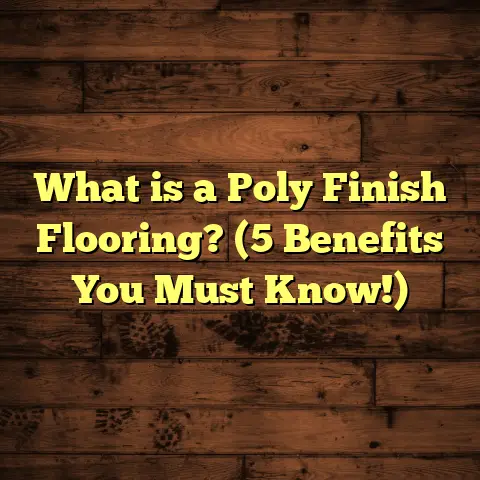What is Stone Flooring Made Of? (5 Key Materials Explained)
One mistake I see a lot of people make when they start exploring stone flooring
is assuming all stone floors are basically the same or made from a single type
of material. I’ve been in the flooring business for years, and I can’t tell you
how many times homeowners call me up saying they want “stone flooring” but
don’t really know what that means. They might picture granite when they actually
want marble, or they might not realize how different natural stone is from
engineered stone tiles.
That’s why I want to take you through the real story behind stone flooring,
breaking down the materials so you get a solid understanding before making
a choice that sticks with you for years. Because believe me, picking the wrong
stone can lead to regrets—be it because of durability issues, maintenance headaches,
or costs spiraling out of control.
What Is Stone Flooring Made Of?
Stone flooring is any flooring surface created from natural rock materials. These
stones are quarried from the earth, cut into slabs or tiles, then installed to
create floors that are both stunning and long-lasting. But “stone” isn’t just one
thing—it’s a family of materials each with its own characteristics that affect
how it looks, how it wears, and how you care for it.
The five main types of stone I work with most often are:
- Granite
- Marble
- Slate
- Limestone
- Travertine
Each comes from different geological processes and has its own personality. Let’s dig deeper into what makes each one tick—and how that impacts your floor.
1. Granite – The Tough Warrior
Granite is an igneous rock formed deep inside the earth as molten magma cools slowly over thousands of years. It mainly consists of quartz, feldspar, and mica minerals that give it its characteristic grainy texture and speckled appearance.
I love granite for its toughness. On the Mohs hardness scale—which measures how resistant a material is to scratching—granite scores around 6 to 7 out of 10. That means it’s hard enough to resist everyday wear and tear better than almost any other natural stone flooring option.
I remember installing granite floors in a busy restaurant kitchen where heavy foot traffic and dropped pots were constant challenges. Years later, the floor still looked almost new because granite resists scratches and stains so well.
Why Granite Works Well:
- Durability: Granite is dense and hard; it won’t chip easily.
- Heat Resistance: Great near fireplaces or kitchen stoves.
- Low Porosity: It absorbs very little water (less than 0.5%), which reduces staining risk.
Key Data About Granite Flooring:
| Feature | Data/Info | Notes |
|---|---|---|
| Cost per square foot | $10–$30 | Depends on finish & grade |
| Density (g/cm³) | 2.63 to 2.75 | High density means durability |
| Porosity (%) | < 0.5 | Very low, good stain resistance |
| Mohs Hardness | 6–7 | Hard and scratch-resistant |
| Maintenance | Seal annually | Keeps surface protected |
When customers ask me about granite floors for their homes, I often highlight these benefits. It’s perfect for entryways, kitchens, or any surface that takes regular abuse.
2. Marble – The Classic Beauty
Marble is a metamorphic rock created when limestone undergoes intense heat and pressure deep underground. Its main mineral is calcium carbonate, and it’s this that creates marble’s famous veins—those swirls and lines that make every slab unique.
Marble floors bring a sense of luxury and timelessness to any space. But here’s my honest take: marble is softer than granite (Mohs hardness about 3-4), which means it scratches more easily and can stain if you’re not careful.
I once worked on a bathroom renovation where my client was set on marble floors despite having young kids who are prone to spills. I advised them about the risks—especially acid etching caused by common household cleaners or fruit juices—but they loved marble’s smooth feel and classic look so much they decided to go for it.
To mitigate some of these issues, we chose a honed finish instead of polished marble. The honed finish is matte, which hides scratches better even though it still requires regular sealing.
Things to Consider With Marble:
- Softness: Can scratch and chip easier than granite.
- Porosity: Medium (2–4%), prone to absorbing liquids if unsealed.
- Maintenance: Needs frequent sealing and gentle cleaning agents.
Marble Flooring Facts:
| Feature | Data/Info | Notes |
|---|---|---|
| Cost per square foot | $15–$50 | Premium stone |
| Density (g/cm³) | ~2.7 | Slightly less dense than granite |
| Porosity (%) | 2–4 | Medium; sealing required |
| Mohs Hardness | 3–4 | Softer; prone to scratches |
| Maintenance | Seal every 6 months recommended | Use pH-neutral cleaners |
One project that taught me a lot was for an upscale hotel lobby where marble flooring was installed with radiant heating underneath. The combination gave the space a warm yet sophisticated feel but also meant we had to be extra cautious during installation not to crack the slabs.
3. Slate – The Earthy Performer
Slate is a fine-grained metamorphic rock derived from shale-type sedimentary rock composed mostly of clay minerals. It has a layered structure that gives it natural clefts and texture.
I really like slate for its rustic look and strong slip resistance thanks to its slightly rough surface texture. It’s a top choice for outdoor patios, mudrooms, kitchens—places where you want natural beauty plus practical performance.
What surprised me when I first started installing slate was how easy it is to maintain compared to softer stones like marble or limestone. It doesn’t show dirt easily either, which clients appreciate in high-traffic areas.
Key Slate Properties:
- Slip Resistance: Natural cleft makes it safe in wet areas.
- Durability: Hard enough for most residential uses.
- Cost: Generally more affordable than granite or marble.
Slate Flooring Facts:
| Feature | Data/Info | Notes |
|---|---|---|
| Cost per square foot | $6–$15 | Budget-friendly option |
| Density (g/cm³) | ~2.7 | Dense stone |
| Porosity (%) | 1–5 | Medium; sealing recommended |
| Mohs Hardness | 5–6 | Moderately hard |
| Maintenance | Seal every 1-2 years | Use non-acidic cleaners |
One slate project I remember fondly was in a mountain cabin where homeowners wanted a floor that could handle muddy boots but still look beautiful. Slate fit the bill perfectly—rugged but stylish.
4. Limestone – The Subtle Charm
Limestone is a sedimentary rock made mostly of calcite (calcium carbonate). Its color palette tends toward soft creams, beiges, and light grays that brighten spaces without overpowering them.
Limestone floors feel warm underfoot but are softer and more porous than granite or slate. That means they can scratch or stain easier if not sealed properly—which many first-time buyers don’t realize until damage appears.
I usually recommend limestone for living rooms or bedrooms where traffic is moderate but where people want natural tones with less texture than slate offers.
Limestone Characteristics:
- Softness: Softer than granite/slate; more prone to wear.
- Porosity: High (up to 10%), needs frequent sealing.
- Appearance: Soft colors that complement many design styles.
Limestone Flooring Facts:
| Feature | Data/Info | Notes |
|---|---|---|
| Cost per square foot | $5–$15 | Affordable natural stone |
| Density (g/cm³) | ~2.3 | Less dense than granite |
| Porosity (%) | Up to 10% | High; sealing critical |
| Mohs Hardness | 3–4 | Softer; scratches possible |
| Maintenance | Seal every few months | Avoid acidic cleaners |
I installed limestone floors in an art gallery once—the subtle tones really helped showcase the artworks without distraction. That project gave me a new appreciation for limestone’s understated beauty.
5. Travertine – The Textured Marvel
Travertine is a form of limestone deposited by mineral springs, especially hot springs. It has unique porous holes and troughs on its surface that give it character and texture.
Travertine brings both luxury and subtle texture to floors. It sits between marble and granite in hardness (Mohs scale around 3-4), so it requires care but offers good slip resistance thanks to its natural pits once filled properly.
In my experience, travertine works well indoors or outdoors—from sunrooms to patios—because it combines warmth with durability.
Travertine Features:
- Texture: Natural pits add depth but need filling before sealing.
- Versatility: Great in many settings due to slip resistance.
- Care: Requires sealing and filling holes regularly.
Travertine Flooring Facts:
| Feature | Data/Info | Notes |
|---|---|---|
| Cost per square foot | $7–$20 | Mid-range pricing |
| Density (g/cm³) | ~2.5 | Medium density |
| Porosity (%) | 10–15 | High; sealing & filling needed |
| Mohs Hardness | 3–4 | Softer stone |
| Maintenance | Seal & fill holes yearly | Regular upkeep vital |
One client used travertine tiles in their sunroom, and the natural pits filled with grout gave the floor an interesting texture that caught sunlight beautifully throughout the day.
How These Materials Stack Up: A Comparison Table
To help you see differences quickly, here’s a side-by-side look at these five stones:
| Material | Mohs Hardness | Porosity % | Cost per sq ft | Maintenance Frequency | Best Uses |
|---|---|---|---|---|---|
| Granite | 6–7 | <0.5 | $10–$30 | Seal annually | Kitchens, high traffic |
| Marble | 3–4 | 2–4 | $15–$50 | Seal every 6 months | Bathrooms, elegant spaces |
| Slate | 5–6 | 1–5 | $6–$15 | Seal every 1-2 years | Mudrooms, patios |
| Limestone | 3–4 | Up to 10 | $5–$15 | Seal every few months | Living rooms, bedrooms |
| Travertine | 3–4 | 10–15 | $7–$20 | Seal & fill yearly | Sunrooms, patios |
Real-Life Case Studies From My Work
Case Study #1: Granite Kitchen Overhaul
A family in Texas wanted something durable for their kitchen floor since they cook frequently and have two dogs. They initially considered porcelain tile but switched to granite after I showed them samples.
We chose dark brown granite tiles with polished finish for easy cleanup and stain resistance. I helped them plan installation costs using FloorTally — factoring in local labor rates plus material waste at about 8%. The whole project came in on budget at around $22 per sq ft installed.
A year later, their floor still looks flawless despite heavy use—and they’re thrilled with how easy maintenance turned out.
Case Study #2: Marble Bathroom Elegance
A couple renovating their master bath wanted marble for its luxurious look despite having small children at home.
We selected honed Carrara marble slabs with subtle veining to hide scratches better than polished surfaces. They understood sealing needed every six months and agreed on gentle cleaning routines.
Installation was tricky because we had to reinforce the subfloor due to marble’s weight but the result was stunning: classic elegance without sacrificing function.
Case Study #3: Slate Patio Installation
Outdoor patios face extreme weather changes so durability is key here.
A mountain homeowner contacted me wanting a natural look that wouldn’t slip when wet. We went with hand-split slate tiles with rustic edges for authentic texture plus sealed them with water-resistant sealant.
This slate patio has lasted over five years without cracking or slipping issues despite heavy rain and snow—proof slate can handle outdoor conditions well.
Installation Tips From My Experience
Installing stone flooring requires skill beyond just laying tiles flat:
- Subfloor Prep: Stone slabs are heavy; subfloor must be level & reinforced.
- Mortar Choice: Use polymer-modified thinset mortar for better adhesion.
- Expansion Joints: Needed in large areas to prevent cracking.
- Sealing: Apply sealers after installation; some stones require filling holes first.
- Grout Selection: Choose grout color wisely—it affects overall appearance.
- Cutting Stone: Diamond blades are essential for clean cuts without chipping.
I always advise people not to rush this process because poor installation leads to cracks, uneven surfaces, or water damage later on.
Caring For Your Stone Floors
How you maintain your stone floor depends largely on what type of stone you have:
- Granite: Wipe spills quickly; seal once a year; avoid abrasive cleaners.
- Marble: Use pH-neutral cleaners only; seal every six months; clean spills immediately.
- Slate: Clean regularly; seal yearly; avoid acids.
- Limestone: Frequent sealing; avoid harsh chemicals; use mats in high traffic zones.
- Travertine: Fill holes before sealing; regular cleaning with mild soap.
In my years working with clients, those who keep up with sealing schedules usually extend their floor’s life by decades while maintaining appearance.
How I Use FloorTally To Manage Costs And Planning
Pricing stone flooring projects includes many variables beyond just tile cost: labor rates vary by location; waste percentages differ by material type; prep work might be needed; sealers add extra costs.
FloorTally helps me bring all these factors together quickly by letting me input room dimensions and choose specific stone types while pulling local price data for materials and labor automatically.
This tool saves hours of back-and-forth quotes and gives clients transparent estimates upfront — something I’ve found builds trust immediately.
For example, when estimating a kitchen remodel with granite floors measuring 400 sq ft, FloorTally included about 10% waste factor plus labor rates based on my zip code plus sealing costs — giving me a total project cost breakdown within minutes instead of days.
Final Thoughts From My Experience
Stone flooring offers unmatched natural beauty combined with long-lasting durability—when you pick the right material for your needs and care for it properly.
Granite stands out as tough yet elegant for active spaces; marble brings classic luxury if you’re ready to treat it gently; slate mixes rustic charm with practicality; limestone calms rooms with soft tones but needs more care; travertine adds texture and warmth but requires filling pores regularly.
If you’re thinking about installing stone floors yourself or working with contractors like me, take time upfront understanding what each stone is made of—and how that affects installation, maintenance, durability—and costs.
Using tools like FloorTally makes budgeting easier too by giving accurate cost estimates based on real local data rather than guesswork—something I rely on every time I quote jobs.
Got questions about specific stones or need advice on installation? Just ask—I’m happy to share what I’ve learned after years working hands-on with stone flooring!
If you want me to expand any particular section further (like installation methods, cleaning tips by stone type, detailed project timelines, or even regional cost differences), just let me know!





